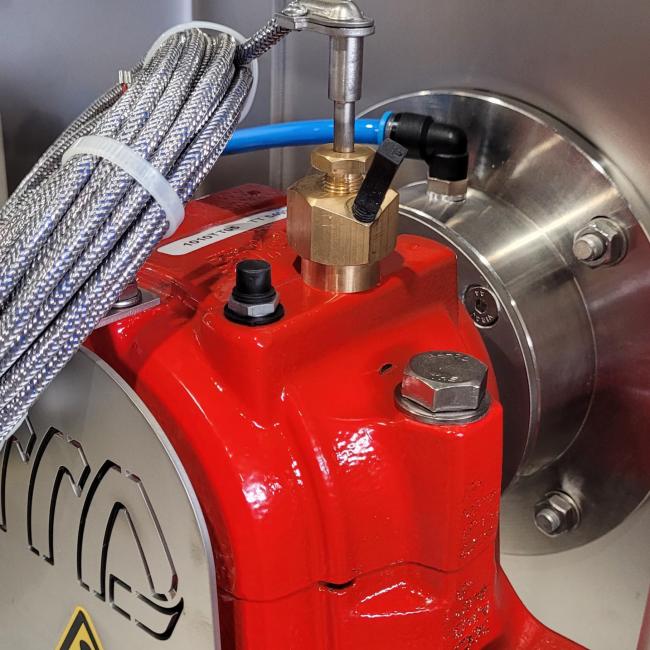This article contains information about the Dutch Norm Explosive atmospheres (Part 37): non-electrical equipment for use in explosive atmospheres, with attention to:
- Risk of ignition of bearings
- Ignition hazard of drives
- The types of ignition protection: b1 and b2
The experts at Dinnissen Process Technology are available to answer all your questions:
Get in touch with Juul Jenneskens 077 467 3555
The ignition hazard of bearings
The IP degree of protection, as specified in IEC 60529, provided by the enclosures of the equipment depends on the intended task and the type of environment. The IP degree of protection is given an appropriate rating that is part of the overall investigation into the ignition hazard and thus offers a certain level of protection.
Effective ignition sources such as hot surfaces, mechanically generated sparks or any other form of loss of protection caused by vibrations should be avoided as much as possible. These moving parts that cause vibrations or friction will appear in the overall ignition hazard investigation. These parts must then be reassembled. Small spaces between the unlubricated moving parts and solid parts can also create friction causing hot surfaces or mechanical sparks. However, these clearances must be designed so that the probability of such an effective ignition source matches the intended Equipment Protection Level (EPL).
When it comes to the ignition hazard of bearings, the following aspects should be considered:
- The suitability of the bearings for the intended purpose of the equipment,
- the estimated service life as described in ISO 281,
- correct placement in their housing and on the shaft, taking into account the vertical and axial loads on the bearing,
- correct alignment,
- the axial and radial load that can arise under the most severe conditions due to thermal expansion of the shaft and the housing,
- protection against ingress of water and solids,
- protection for electrical currents, such as leaking circulating currents, which can cause sparks,
- adequate lubrication,
- maintenance checks at specified intervals,
- replacement of the bearings after wear or otherwise at the end of the recommended life;
- protection of the bearing against vibrations, especially when stationary,
- the use of low reliability non-metallic bearing cages in industrial processes,
- If a special trial period is required that could lead to possible ignition sources, the information is given in the instructions.
Danger of ignition of drives
Drives must also meet conditions that can prevent ignition hazards. Gear drives must meet the conditions as stated in 5.1 of the NEN standard. If there is still a chance of an ignition source, another form of ignition protection must be used. This will then determine the overall ignition hazard investigation. When it comes to belt drives, there are two categories, synchronous drive and friction drive. With the synchronous drive, there is a high risk of high surface temperatures that could pose a hazard. This is in contrast to the friction drive, where the friction rarely generates heat.
Belt drives are not used in parts of the equipment that require construction Ga or Da according to the EPL. Belts meeting the requirements of ISO1813 and ISO 9563 are suitable for equipment Mb, Gb or Db, except for the Group IIC applications. In addition, the speed of the belt must not exceed 30 meters per second and belts with connectors that have a higher speed than 5 meters per second are not used at all. Chain drives must also meet the conditions set out in 5.1 of the NEN standard. When operating at a speed greater than 1 meter per second, they must be equipped with special means that provide a continuous good connection between chain and sprocket. In this way an effective ignition source can be prevented. If this is not possible, it must be equipped with a device that removes the driving force from the sprocket if the chain breaks, disconnects or loses its power.
Flexible couplings operated within their design parameters will not cause hot surfaces to exceed the maximum allowable surface temperature. They also will not disintegrate in a way that creates the potential for an ignition source. Flexible couplings specially designed to accommodate shaft misalignments must be installed so that the alignment does not exceed the maximum values. In particular, the drills in the hubs must be accurate to ensure concentric running of the coupling hubs. In addition, they must have a suitable tolerance to ensure safe and accurate axle mounting.
With conveyor belts there is no chance of electrostatic discharge arising during operations. Conveyor belts can produce hot surfaces and even exceed the maximum surface temperature as a result of slackening or slipping of the belt on the transport driver. In this case, the belts must be fitted with a means that maintains the correct belt tension. This belt tension can be achieved by checking the tension on the belt or by comparing the relative speeds of the drive roller and belt. The latter check can be continuous or carried out by inspection. The manufacturer specifies what the maximum permissible speed difference is. When the relative speeds of the drive roll and belt have been compared, a difference of more than 10% should cause the drive power to shut off. If conveyors have a potential for misalignment to exceed the maximum surface temperature, some means is needed to detect this misalignment.
Parts of the equipment that include a belt must be made of an electrically conductive material. It must also be arranged in such a way that it can serve as a leakage current when static electricity is applied to the belt. The frame contains the drive pulley or drum plus any (tension) rollers associated with the belt drive. A specific electrical connection is needed between all these separate parts and the earth if the electrical resistance of the leakage current to earth is greater than 1 Ω.
To reduce the likelihood of hot surfaces coming into contact with parts of the equipment, some seals require a lubricant that can be replenished. These types of seals should always be designed to have enough lubricant available or be supported by one of the following means:
- a system that constantly checks for the presence of the lubricant.
- a detection device that warns of rising temperatures.
- the equipment must be designed to withstand the proof test without exceeding the maximum surface temperature. In addition, the equipment must not be damaged that could reduce ignition protection.

Gear drive

Temperature sensor in bearing
Small spaces between the unlubricated moving parts and solid parts can also create friction causing hot surfaces or mechanical sparks
Ignition prevention and ignition protection systems b1 and b2
Factors to consider when designing and setting up the ignition prevention system are:
- The rate at which the potential source changes to an effective source,
- The response speed of the sensor or detector,
- The reaction speed of the ignition prevention system,
- The difference in level between the normal parameters and critical parameters,
- Necessary safety factor.
If the ignition prevention system is able to shut down the equipment and thereby reduce the likelihood that a potential ignition source becomes an actual ignition source, the system must be set to lock out the stop function. As a result, the equipment must first be reset in order to start.
A level b1 ignition protection system must meet the following conditions:
- If a control parameter passes a critical value, action must be taken. This action should reduce the chance that an ignition source will ignite. Instead of this action, a warning can also be given that an ignition source is developing.
- The ignition protection system is checked at appropriate intervals. This check must be designed in such a way that any loss of the safety function is detected.
- The manufacturer's instructions in ISO80079-36 provide more information on the exact time between maintenance checks and advice on these checks.
A level b2 ignition protection system must meet the following conditions:
- If a control parameter passes a critical value, action must be taken to reduce the likelihood of a ignited ignition source.
- The ignition protection system is checked at regular intervals so that any loss of the safety function can be detected.
- If a fault occurs in the ignition protection system, it does not reduce protection from the protection system.
- The manufacturer's instructions in ISO80079-36 specify the time between maintenance checks on the sensor and ignition protection systems.
In the table the applications of the two types of ignition protection can be found again.
| Intended EPL | Result of the ignition hazard assessment for existing equipment | Necessary control system | Type of ignition protection |
| Gc, Dc |
|
|
|
| Gb, Db |
|
|
|
| Ga, Da |
|
|
|

Name: Juul Jenneskens
Advisor
Please feel free to contact me if you have any questions about this subject. My team of colleagues and I are ready to answer!
Get in touch with Juul Jenneskens 077 467 3555 [email protected]
Do you prefer to request a consultation directly?
